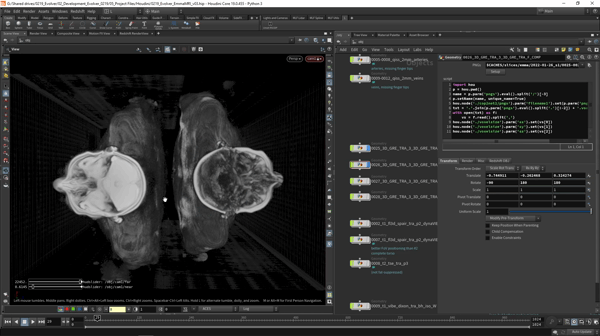As an artist collective, Marshmallow Laser Feast seeks to find emotional resonance in scientific stories – stories that connect us to the more-than-human world. When coupled with emerging technologies, these stories deepen our understanding of what it is to be something other than human.
For Sanctuary of the Unseen Forest, Marshmallow Laser Feast undertook ecological surveys and collected field recordings and volumetric data of the kapok tree while embedded in the Amazon rainforest (4°02‘06.8 S 70°04‘44.1 W). This data collection is part of their process for preserving endangered ecosystems and the species that live there and is critical to creating and realistically rendering the artwork. They also spent time in Sequoia National Park (36°34‘58.3N 118°45‘00.4W) studying giant sequoia trees (commonly known as giant redwoods) that you’ve just encountered in We Live in an Ocean of Air. Both trees were scanned using LiDAR (Light Detection and Ranging), which uses light and lasers to measure distance and volume. Computer graphics were then used to digitally render the trees’ inner and outer systems.
Marshmallow Laser Feast harness immersive VR and large-scale projections to recreate the awe we feel in these kinds of natural landscapes. Evolver explores this by shrinking our perspective to follow oxygen through our cavernous respiratory and cardiovascular systems. The meditation and massive works journeying through our body were formed from a collage of scientific datasets, including MRI and CT scans, and blood flow simulations. These were then processed through various software programs, including Houdini, commonly used in VFX in film and TV. The datasets were provided by leading scientific collaborators, including the Fraunhofer Institute for Digital Medicine MEVIS, Jennifer Garrison of Buck Institute for Research on Aging and the Allen Institute for Cell Science, among others.
Artist statements
“These giant trees are portals through which you leave your self-importance behind and embody something much larger, much stranger, much more than human.
What is it like to be one of the largest organisms that has ever existed?
How does it feel to host a vast web of relationships that anchor an ecosystem?”
– Marshmallow Laser Feast
“As technology advances, our curiosity for who we are amplifies. By exploring time, scale and space, we begin to see things from a new perspective – begin to build a stronger relationship to the world we live in and the life it sustains.”
– Nell Whitley of Marshmallow Laser Feast
“Modern science is helping to reveal something Indigenous knowledge has always held to be true – that what is outside of us is not separate from us. This ancient wisdom is needed more than ever today. And it compels us to use our technology to both honour and deepen our intricate relationships with the web of beings, reminding us, with awe, that we are all but extensions of one another.”
– Marshmallow Laser Feast
Works of Nature Soundscape: Breath
While developing the artworks featured in Works of Nature, Marshmallow Laser Feast conducted a series of interviews with the foremost thinkers on nature, life and the more-than-human world. These include internationally renowned cultural ecologist and geophilosopher Dr David Abram, Professor of Plant-Soil-Processes at the University of Sheffield Katie J Field, author and founder of Schumacher College Dr Stephan Harding, and biologist and bestselling author Dr Merlin Sheldrake.
In this episode, they discuss how breath connects us to the natural world – and each other.
Works in this group
Related articles
Related works
Related events
Content notification
Our collection comprises over 40,000 moving image works, acquired and catalogued between the 1940s and early 2000s. As a result, some items may reflect outdated, offensive and possibly harmful views and opinions. ACMI is working to identify and redress such usages.
Learn more about our collection and our collection policy here. If you come across harmful content on our website that you would like to report, let us know.
How to watch
Works in this group have been digitised and are viewable by following the links below.
Collection
Not in ACMI's collection
Previously on display
14 April 2024
ACMI: Gallery 4
Collection metadata
ACMI Identifier
195690











